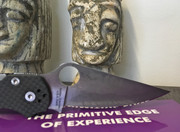Hi folks,
Relatively new to the board but have read. I thought I'd share my paper wheel journey and ask for advice on improvement.
I got into sharpening just a couple years ago. I started free hand with sandpaper taped to a board. As a teenager long ago I tried a 2 sided diamond paddle (smith's?) on a Gerber AR no-name knives and didn't have the patience.
Then on the handgun side of things I polished a feed ramp of a pistol barrel to a near mirror shine with just a $3 rouge cloth and my pinky. Well, my both pinkies, both index fingers, then a pencil eraser when my fingers were sore and swollen.
I was surprised at the power of rouge - ferrous oxide? - such simple abrasive compound can change metal.
So I bought a 1 pound block of rouge/wax off amazon and rubbed it on a cardboard box and used it to "strop" my knifes. My only real user was a Kershaw Cryo that has now been with me for 5+ years I think.
It went well but after a while due to the cardboard softening and my imperfect technique, I ended up with a blunt convex edge. It was shiny however

Then I'd have to return to the sandpaper.
So I saw these paper wheels and I bought them - and my first (and only) grinder at the same time. Actually the grinder was a gift from my wife. She's perfect.
My rationale and current thoughts on the paper wheel niche were this: It's like stropping - not too aggressive. More consistency as no movement at the start and finish of a stroke like freehand work would have.
Unfortunately I took advice meant for stone wheels in preparing the paper wheels. I used the diamond shaper tool (to true up a grinding wheel) and made a rounded surface with the middle of each wheel sticking out forward for both the polishing and grit wheel. I stopped partway on the grit wheel because it was removing too much grit.
But the polishing wheel worked and continues to do so for 8Cr13MOv, 400c and 154 CM. I actually get away with using the polishing wheel only on those and the blades push cut phone book paper easily. I try to keep factory angles, try not to press hard, and keep the polishing wheel loaded before each use.
My difficulty comes in 2 areas.
1: I've never been able to get a precise angle. I know some folks label their wheels with lines and hold the blade horizontal to the wheel. But the primary bevels kind of confuse me as to what is "horizontal" when I try this. And I hate math. 8 inch wheels. So I alternate between trying to find the top of the wheel and holding it at a diagonal across the wheel at the correct angle like I'm freehand sharpening on sandpaper, or horizontally trying to look for when the shadow of the cutting edge disappears and taking that as contact to the cutting surface.
2: I now have my first S30v knife and I'll tell you the buffing wheel alone has NOT been enough. In fact I think maybe it tends to round / blunt the apex. Previously I've used 1000 rpm's with great success on the softer steel, so I tried ~2,500 with not a ton of improvement. I've broken down and used the grit wheel and while it's better it's not fast enough to thin this thick factory edge. So I went back to a freehand diamond paddle (smith's with the holes on surface) and thinned the shoulder like I wanted to, but it was slow.
How do you all achieve the precision to reprofile to exact angles?
Any benefit if I were to switch from white buffing compound to the red block I have?
My thoughts about polishing wheel and low rpm's: I kept it low to avoid removing too much metal. But I believe it leads to a tendency to push harder for results and a more bumpy surface. And I believe the "give" or softness of the surface is reduced at higher RPM's so it would lead to less convexing if I cranked it up, and less polishing of areas above the grind.
thoughts?





































